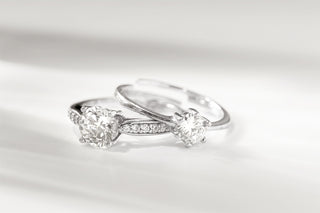The 4C's are what is known as the official criteria a diamond is graded against, namely the Carat, Clarity, Colour and Cut of a precious stone. Along with the diamonds that feature in our collections, each diamond that we use within our bespoke designed pieces here at Pavilion Jewellers has been certified by an official body such as the GIA and examined against these criteria by a qualified external gemologist. Understanding a little background behind each of the 4C's will give you the insider knowledge you need when shopping around, and along with the help from our in studio experts will help you select the perfect stone for you.

DIAMOND CARAT
Contrary to popular understanding, a diamonds carat refers to its weight as opposed its size, although in most cases the higher the carat the larger the diamond. Dating back to the 16th century, jewellery was measured using carob seeds which were thought to be a reliable counterweight due to the little variance in their mass, which explains where the name carat originates from. Of course there are many factors that make up the beauty of a diamond besides its weight and appearance in size, perhaps one the largest contributing factors is the skill in cutting the diamond to accentuate its natural beauty and optimise sparkle.
- Definition: A diamond’s carat measures its weight, not its size, though higher carat diamonds often appear larger.
- Historical Origin: The term "carat" comes from carob seeds, once used for their consistent weight as a measurement standard.
- Key Insight: A diamond’s beauty isn’t just about its weight but also its cut, which enhances its natural brilliance and sparkle.

DIAMOND CLARITY
As the diagram above illustrates, the clarity grading of the diamonds Pavilion Jewellers work with run from Flawless to Slightly Included, and refers to the absence of imperfections and blemishes in the stone. Each diamond is evaluated for the number of both internal and external inclusions, the size, position and nature of these characteristics, as well as the impact they have on how the stone appears.
- What It Means: Clarity refers to the absence of imperfections (inclusions and blemishes) in a diamond.
- Grading Scale: Piperno & Fuller’s diamonds range from Flawless to Slightly Included, reflecting the size, position, and nature of these characteristics.
- Impact: Fewer inclusions generally mean greater visual appeal and value.

DIAMOND COLOUR
A diamond pure and perfect in structure will have no colour at all, completely clear in appearance. The grading starts at D as an exceptionally white diamond and works through alphabetically through to J the more colour a stone is graded to have. These differences in colour are a component that effects how expensive a stone will be. The clearer the diamond, the higher in value it becomes. When visiting us in store we will be happy to guide you through the options and to the right grade of diamond to suit your requirements and budget.
- Grading: Colourless diamonds are the most sought-after, with grading starting at D (exceptionally white) and progressing through J (more color visible).
- Effect on Value: Clearer diamonds typically command higher prices.
- Customisation: Our in-store team will guide you to find a diamond grade that balances your aesthetic preferences and budget.

DIAMOND CUT
Different to the shape of a diamond, a diamond's cut is skilfully crafted to maximise its interaction and transmission of light. It is a complex process with many considerations to achieve the best cut for each individual stone. A master craftsman will work at the depth, the table, the height and angle of the crown and its girdle thickness. Each of these factors along with others will affect the grading of a stone as well as its durability and the way it directs light.
- Definition: The cut defines how well a diamond interacts with light, affecting its brilliance, fire, and sparkle.
- Process: A skilled craftsman meticulously shapes the diamond, considering its depth, table, crown angle, and girdle thickness.
- Importance: A superior cut enhances a diamond's durability, appearance, and light performance.
FAQ: Common Questions About the Diamond 4C’s
-
What is the most important of the 4C's?
While all 4C’s contribute to a diamond’s value, many consider the Cut the most important because it directly affects brilliance. -
Does a higher carat mean a better diamond?
Not necessarily. Carat measures weight, but a well-cut, smaller diamond can outshine a larger one. -
What does "Flawless" mean in diamond clarity?
A Flawless diamond has no visible inclusions or blemishes when viewed under 10x magnification. -
How does diamond colour impact price?
The less colour a diamond has (closer to grade D), the rarer and more valuable it becomes. -
Can I prioritise one C over the others?
Yes, depending on your preferences and budget, you can focus on the characteristics that matter most to you, like size, sparkle, or clarity.
This guide ensures you’re equipped to make an informed choice, with the support of Pavilion Jewellers experienced team to help find the perfect diamond for your needs.
